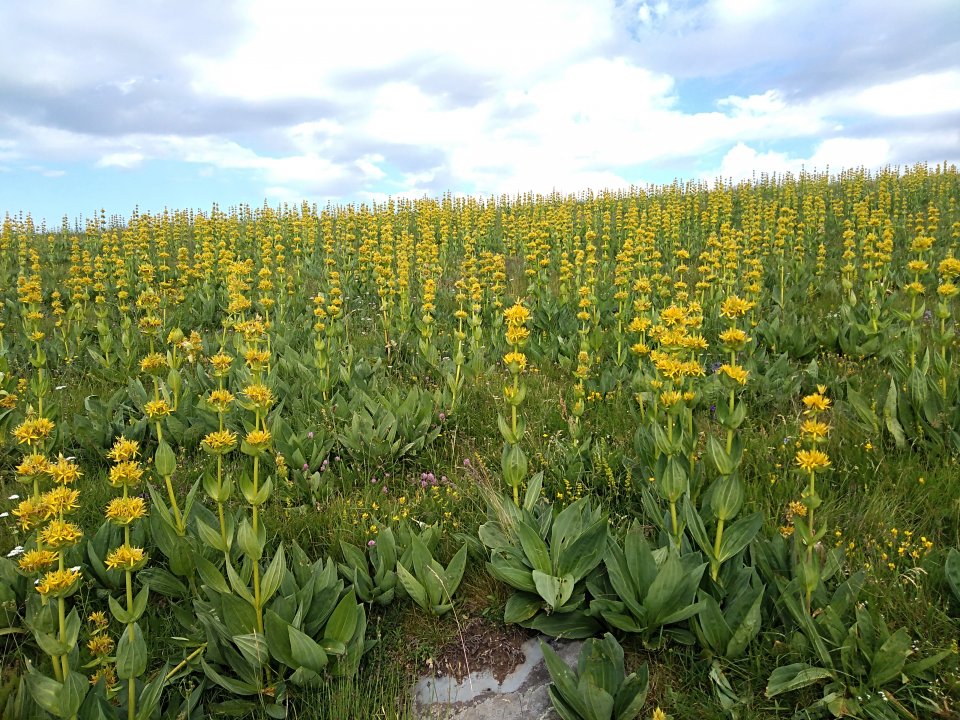
The Yellow Gentian (Gentiana lutea) is a wild plant harvested for its roots at the age of 20 to 30 years old. It is highly valued but little protected. A large part of the production is exported from the source in its raw state. The "Mission for the sustainable management of gentian resources in the Massif Central", a project promoted by the harvesters, helps the different members of the sector to organize themselves to work on good production practices and to ensure the sustainable use of the plant. This work is enhanced by a parallel project to create a "Sustainable Gentian" brand.
Gentian is not an endangered plant, but it is the object of a significant commercial exploitation: wild root production is currently estimated around 2,000 t/year.
Since 2010, producers (harvesters) are wondering about the impact of agricultural practices and harvesting methods, as well as the state of the wild resource and its regeneration.
At the time, the sector is not structured. The different stakeholders knew little about each other.
There is practically no economic data to help implement management measures.
1/ Structuring of the sector: creation of the interprofessional association of yellow gentian which brings together all the stakeholders in the sector and allows the implementation of project groups and working together on sustainable management issues.
2/ Work on good production practices: scientific observations, cultivation trials and sharing of field experiences for a better knowledge of the plant. Creation of a good practice guide.
3/ Creation of new tools to improve production conditions: model contract (landowner/harvesters), regulatory annex (status of regulations and protected areas), dossier on the statutes of harvesters.
Good Production Practices:
- Choice the harvesting area: search for the owner of the land and check the regulations in application; estimate the ideal population (density and size of roots); respect a 20-year rotation between two uprooting operations.
- Purchase the gentian to the owner per kilo; keeping a record of the weights.
- Harvesting practices: between May and October; soil is dry but not desiccated; respect the livestock areas; between 60 and 80 % of mature plants could be harvested depending on the presence of young plants; preferably harvesting by fork; put the clods back in place and plug the holes.
Respecting the “good production practices guide” is a good tool at plot level, but over a larger area, resource management must be envisaged with a dialogue between the different levels of the sector and take into account the social and economic dimensions.
The sector is essentially based on the exploitation of a natural resource carried out by harvesters without proper statutes, lack of economic essential data for the management of the resource.
Another weak point is the control of good production practices.
The association « Gentiane jaune » is working on the creation of a brand "Sustainable Gentiane " which presents several interests:
- Control of good production practices.
- Collection of reliable economic information with respect for individual data.
It is a resource management tool at the scale of a territory, but also for the promotion of the gentian product among buyers and consumers.
This approach would find a real dimension by benefiting from regulatory support and working together with the authorities in charge of environmental protection.
Stéphanie FLAHAUT; Stephanie.flahaut@cpparm.org; https://www.cpparm.org/la-gentiane/
Further information
All documents produced within the framework of the Mission for the Sustainable Management of Gentian Resources can be downloaded from: https://www.cpparm.org/la-gentiane/ :
- Guide de bonnes pratiques de production de gentiane (version 2019)
- Annexe 1 : contrat-type d’exploitation de racine de gentiane
- Annexe 2 : état des réglementations et des espaces protégés
- Annexe 3 : dossier statuts des arracheurs
Large population of gentian on a meadow in the Massif Central. Photo : Stéphanie Flahaut
Underground part of a Gentian plant: rhizome + root system. Photo : Stéphanie Flahaut
